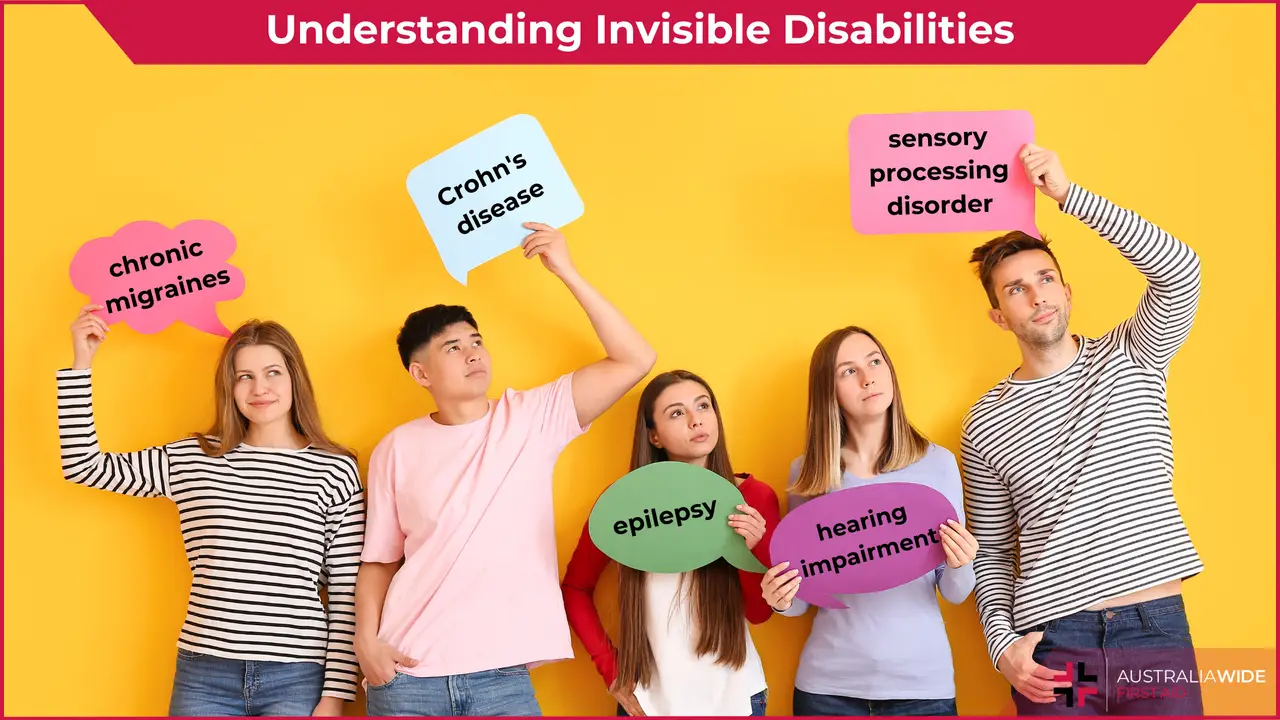Understanding Invisible Disabilities: A Comprehensive Guide


Invisible disabilities are medical conditions that affect people in ways that may not be immediately apparent to others.
Unlike visible disabilities, which are evident through physical signs or mobility aids, invisible disabilities often remain hidden. Their symptoms may not be evident to anyone but the person themselves.
These conditions can significantly impact a person's daily life. This makes it essential for first aid responders and caregivers to understand and be able to recognize them.
Invisible disabilities encompass a broad range of medical conditions, each with its unique set of challenges.
These conditions may affect a person's physical, mental, or cognitive well-being, leading to varying degrees of impairment.
They can be considered ‘invisible’ if:
Despite their hidden nature, they can have a profound impact on an individual's quality of life. This includes getting an accurate diagnosis. Often those with hidden disabilities wait years for an accurate diagnosis, which delays treatment and causes further impacts.
Invisible disabilities are more common than one might think.
According to the World Health Organization (WHO), approximately 15% of the world's population is estimated to live with a disability. While not all of these disabilities are invisible, many fall into this category.
In Australia, there are 4.4 million people living with one or more disabilities. Of these, at least 90% have one or more invisible disabilities.
That’s 3.96 million Australians living with an invisible disability. Chances are, someone you know falls into this category.
It's essential to recognize the prevalence of these conditions to better understand the importance of accommodating and supporting individuals with invisible disabilities. For example, many invisible disabilities qualify for a disabled parking sticker – just because they are not using a physical aid does not mean they don’t need the support of parking closer to their location.
Chronic Pain: Conditions such as fibromyalgia, complex regional pain syndrome (CRPS), and chronic migraines can cause persistent and debilitating pain. Those affected may appear physically healthy but are enduring constant discomfort.
Mental Health Disorders: Mental health conditions like anxiety disorders, depression, bipolar disorder, post-traumatic stress disorder (PTSD), and schizophrenia. These invisible disabilities can significantly affect an individual's emotional and psychological well-being. They can also disrupt their ability to function normally on a day-to-day basis. While they can be stand-alone disorders, they can also be present with others and compound their impact.
Autoimmune Diseases: Conditions like rheumatoid arthritis, lupus, multiple sclerosis, and Crohn's disease are examples of autoimmune diseases. They can cause unpredictable flare-ups, fatigue, and pain, making daily life challenging.
Sensory Processing Disorders: Autism spectrum disorder (ASD) and sensory processing disorder (SPD) affect an individual's ability to process sensory information. This can lead to sensory overload, heightened sensitivities, and difficulty with social interactions. Different individuals experience issues with different sensory inputs, and therefore these disorders can be difficult to diagnose.
Chronic Fatigue Syndrome (CFS): CFS, also known as myalgic encephalomyelitis (ME), is characterized by extreme and persistent fatigue that doesn't improve with rest. It often leads to a profound loss of physical and mental stamina.
Invisible Hearing and Vision Impairments: Some individuals have hearing or vision impairments that are not immediately apparent. Hearing impairments, in particular, can be difficult or impossible to notice. The impact of these conditions make it essential to be aware and adapt communication methods accordingly.
Neurological Conditions: Conditions like epilepsy, Parkinson's disease, and multiple sclerosis can result in a range of symptoms, including seizures, tremors, and impaired mobility. Sometimes these conditions do not present continuously, or are well managed through medications.
Developmental Disorders: Invisible disabilities in children can be overlooked, often because of their difficulty in articulating problems. One such example is attention deficit hyperactivity disorder (ADHD). This disorder significantly impacts the ability to focus and control impulsivity, and can last into adulthood.

Treatment of these hidden disabilities depends entirely on the type of disability. Likewise, the signs and symptoms vary drastically.
Many can be managed with various treatment options to the extent that they aren’t evident in public.
Medical diagnosis is required for many to be considered a disability for government support.
People living with these disabilities may work with doctors, occupational therapists, mental health professionals, and community support workers to manage their symptoms.
Supporting someone with a hidden disability can start with the simple act of asking them directly. They will often know exactly what you can support them with, and will appreciate the offer.
Within the workplace there can be a lot of stigma surrounding invisible disabilities. Due to this, employees may not disclose this information to their employer, despite their need for adjustments or support. If an employee does choose to disclose this information, it is part of the Disabilities Discrimination Act to provide appropriate support to allow them to do their job.
Family members are commonly the best place to offer support during everyday life, but everyone can become educated and aware.
Invisible disabilities are a diverse group of conditions that impact the lives of millions of individuals worldwide.
Despite their hidden nature, they can significantly affect an individual's daily life, including their physical, emotional, and cognitive well-being.
As first aid responders and caregivers, it is crucial to be aware of these conditions, to be empathetic, and to provide support when needed.
By understanding what invisible disabilities are and recognizing their prevalence, we can work together to create a more inclusive and supportive environment for all individuals, regardless of the challenges they face.

March 25, 2025
Explore non-traditional paths to sobriety, including mindfulness, yoga, nutritional therapy, and community-based support, for a personalized approach to recovery.

September 7, 2022
Menopause is the final period, when a woman, trans man, or non-binary person assigned female at birth's ovaries run out of eggs and the body can no longer ovulate. Menopause comes with several symptoms, complications, and treatment options.

July 26, 2024
Transcutaneous Electrical Nerve Stimulation (TENS) is a therapeutic method of pain relief. It utilises an electrical device that emits electrical currents and streams the impulses via electrode patches attached to the skin.